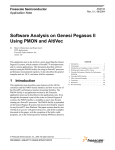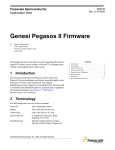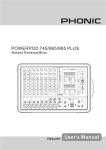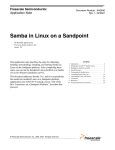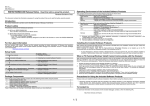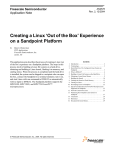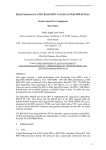Download AN2744:PMON Module—An Example of Writing Kernel Module
Transcript
Freescale Semiconductor
Application Note
AN2744
Rev. 1, 12/2004
PMON Module—An Example of Writing Kernel Module
Code for Debian 2.6 on Genesi Pegasos II
by
Maurie Ommerman
CPD Applications
Freescale Semiconductor, Inc.
Austin, TX
This application note is the seventh in a series describing the
Genesi Pegasos II system and its various applications.
1
Introduction
This application note describes the PMON kernel module
interface and how to write, compile and link a kernel module. As
an example the PMON facility, which is an application written by
the application team and is described and developed in the
applications note Software Analysis on Genesi Pegasos II Using
PMON and AltiVec (AN2743).
This paper assumes that the user will log in as guest with
password guest, and all the examples discussed in this paper are
in the /root/ppctools/pmon directory. However, all the code and
commands must be done as the root user in the /root directory.
Hence, the guest user will need to switch to the root user with this
command:
su -
© Freescale Semiconductor, Inc., 2004. All rights reserved.
PRELIMINARY—SUBJECT TO CHANGE WITHOUT NOTICE
Contents
1. Introduction . . . . . . . . . . . . . . . . . . . . . . . . . . . . . . . . . 1
2. Terminology . . . . . . . . . . . . . . . . . . . . . . . . . . . . . . . . 2
3. Introduction to Building a Kernel Module on Debian
Linux 2.6 Kernels. . . . . . . . . . . . . . . . . . . . . . . . . . . . 2
4. Writing the Module . . . . . . . . . . . . . . . . . . . . . . . . . . . 5
5. Instantiating any Module . . . . . . . . . . . . . . . . . . . . . 12
6. References . . . . . . . . . . . . . . . . . . . . . . . . . . . . . . . . . 14
7. Document Revision History . . . . . . . . . . . . . . . . . . . 14
Terminology
2
Terminology
The following terms are used in this document:
Linux OS
PMON
gcc
GNU
Performance monitors
Kernel
Root file system
Module
POSIX
3
Linux operating system
Performance monitor facility
GNU compiler collections and GNU utilities
GNU is not Unix (a recursive acronym)
The MPC74xx processors contain registers that can be used to monitor system activity.
The part of the Linux system which runs in memory and controls the system operations.
Linux is composed of two parts, the kernel and the root file system.
The collection of directories and files that are used by the kernel to affect all operation.
A dynamic facility for attaching kernel code to a running kernel, allowing the kernel to
be expanded and contracted as needed.
The Portable Operating System Interface (POSIX) standardization effort used to
be run by the POSIX standards committee.
Introduction to Building a Kernel Module on Debian
Linux 2.6 Kernels.
The process described here is for modules in the 2.6 Linux Kernel family. The process for the 2.4 Linux kernels is
different and will not be discussed here. In particular, this process works on the Genesi Pegasos II Linux 2.6 Debian
kernel.
3.1
Building the Module
A special form of the Makefile and make command are used to build 2.6 kernel modules.
root@debian:~/ppctools/maurie-pmon# cat Makefile
#linux 2.6 makefile
obj-m := pmon26.o
clean:
rm -rf *.o *.ko *.mod.c
root@debian:~/ppctools/maurie-pmon#
The target must be obj-m and the dependency is the name of the source file with the ‘.o’ appended. Thus, for this
example, the source file is pmon26.c and the dependency then is pmon26.o.
The clean target is optional and is used here to clean up the directory by removing all objects and kernel objects,
denoted by .o and .ko respectively and the interim *.mod.c file.
The make invocation is in the script, build.sh.
root@debian:~/ppctools/maurie-pmon# cat build.sh
make -C /usr/src/kernel-source-2.6.4 SUBDIRS=$PWD modules
This make invocation uses the flag -C to change to the directory containing the kernel source, in this case
/usr/src/kernel-source-2.6.4. The macro SUBDIRS indicates the directory containing the module code and in this
PMON Module—An Example of Writing Kernel Module Code for Debian 2.6 on Genesi Pegasos II, Rev. 1
2
PRELIMINARY—SUBJECT TO CHANGE WITHOUT NOTICE
Freescale Semiconductor
Introduction to Building a Kernel Module on Debian Linux 2.6 Kernels.
case it is the local directory indicated by the shell variable $PWD. Finally, the keyword modules indicates that we
are building a kernel module.
The commands generated by this call to make are shown below.
root@debian:~/ppctools/maurie-pmon# ./build.sh
make: Entering directory `/usr/src/kernel-source-2.6.4'
*** Warning: Overriding SUBDIRS on the command line can cause
***
inconsistencies
make[1]: `arch/ppc/kernel/asm-offsets.s' is up to date.
CC [M]
/root/ppctools/maurie-pmon/pmon26.o
Building modules, stage 2.
MODPOST
CC
/root/ppctools/maurie-pmon/pmon26.mod.o
LD [M]
/root/ppctools/maurie-pmon/pmon26.ko
make: Leaving directory `/usr/src/kernel-source-2.6.4'
The kernel script MODPOST, which is really an executable is used to generate the compile and link options to build
the kernel module, in this case pmon26.ko from the source pmon26.c.The modpost code is also available in the
/usr/src/kernel-source-2.6.4/script directory.
At this point, the 2.6 kernel module, pmon26.ko, is available. It can be instantiated with the insmod command and
destroyed with the rmmod command.The modinfo command gives some info about the module and only looks in
the current directory or the /lib/modules directory.
root@debian:~/ppctools/maurie-pmon# insmod pmon26.ko
root@debian:~/ppctools/maurie-pmon# rmmod pmon26.ko
root@debian:~/ppctools/maurie-pmon# modinfo pmon26.ko
license:
GPL
vermagic:
2.6.4 gcc-3.3
depends:
3.2
Instantiating the Module
The module is instantiated by the insmod command and removed by the rmmod command. When this PMON
module is started it writes a message to the kernel log and when removed it also writes a message to the kernel log.
This log is accessible by the dmesg command. These messages are not part of the kernel or the instantiation, but
are written by the code, thus messages for starting and stopping the module are optional. Section 4, “Writing the
Module,” explains these messages.
PMON Module—An Example of Writing Kernel Module Code for Debian 2.6 on Genesi Pegasos II, Rev. 1
Freescale Semiconductor
PRELIMINARY—SUBJECT TO CHANGE WITHOUT NOTICE
3
Introduction to Building a Kernel Module on Debian Linux 2.6 Kernels.
The command string below shows instantiating and removing the module and using dmesg to see the module start
and stop messages.
root@debian:~/ppctools/maurie-pmon# insmod pmon26.ko
root@debian:~/ppctools/maurie-pmon# rmmod pmon26.ko
root@debian:~/ppctools/pmon# dmesg
Total memory = 256MB; using 512kB for hash table (at c0400000)
Linux version 2.6.4-pegasos (luther@pegasos2) (version gcc 3.3.3 (Debian 20040306)) #1 Mon Mar
22 12:47:08 CET 2004
..................
created proc entry for l2cr, major =254
removed pmon module
..................
3.3
Creating the Interface
For the case of PMON, we are using the interface /dev/pmon, which is created as a char device with all users have
all permissions, i.e. 777. The user by accessing this device can interface to PMON with POSIX calls, like open, read,
write, close, etc. The command to create this char device is mknod, specify the type, c, which is char type, the major
number, which in this case is 254, and the minor number, which is 0. To verify that mknod completed successfully,
do an ls -l on /dev/pmon.
Specifically, the major number is assigned by the insmod pmon26.ko command. The /proc/devices files shows
which major number has been assigned. Thus after the insmod, list the /proc/devices file, determine the PMON
major number, then perform the mknod command with that major number.
root@debian:~/ppctools/pmon# insmod pmon26.ko
root@debian:~/ppctools/pmon# cat /proc/devices
Character devices:
1 mem
4 /dev/vc/0
.... intervening items removed for this example
180 usb
254 pmon
Block devices:
1 ramdisk
3 ide0
... remaining items removed for this example
In this case the major number associated with PMON is 254 as shown above in the /proc/devices listing.
PMON Module—An Example of Writing Kernel Module Code for Debian 2.6 on Genesi Pegasos II, Rev. 1
4
PRELIMINARY—SUBJECT TO CHANGE WITHOUT NOTICE
Freescale Semiconductor
Writing the Module
root@debian:~/ppctools/pmon
root@debian:~/ppctools/pmon# mknod /dev/pmon c 254 0
root@debian:~/ppctools/pmon# chmod 777 /dev/pmon
root@debian:~/ppctools/pmon# ls -l /dev/pmon
crwxrwxrwx
4
1 root
root
254,
0 Jul 12 16:28 /dev/pmon
Writing the Module
This example of the PMON facility consists of a single header file, pmon.h, and a single source file, pmon26.c.
Since PMON is implemented as a char device, the user can interface to it with POSIX function calls, like open, read,
write, close, etc. Therefore, the code has function entry points with IO type functionality, all preceded with the
pmon_ character string. Function names are therefore, pmon_open, pmon_read, pmon_write, etc. When the module
is instantiated by the insmod command, the initialization function, pmon_init_module will be run, and when
removed by the rmmod command, the clean up module, pmon_cleanup_module will be called.
A listing of the code is shown below, the numbers are here to allow for describing the code and should not be
included when coding this program. The numbers are generated by the cat -n shell command.
root@debian:~/ppctools/pmon# cat -n pmon26.c
1
/******************************************************************************
2
* Kernel module for MPC74xx performance monitoring counters
3
* Filename: pmon.c
4
* Feature:
This kernel module is used to read and control all performance
5
*
monitoring counters on MPC7410 and MPC744X processors
6
* Note:
Dependent on /dev/pmon char device which is created after insmod
7
*
is issued and a major number is shown in /proc/devices. Use
8
*
"mknod /dev/pmon c 254 0"
9
*
Once inode is created, user code can then access pmon counters via POSIX
10
*
system calls, e.g. open, release, ioctl, read, write.
11
*
12
* ToDo:
13
* Author: Jacob Pan
14
*
15
* History:
16
*
17
*****************************************************************************/
18
#include <linux/module.h>
19
#include <linux/config.h>
20
#include <linux/init.h>
PMON Module—An Example of Writing Kernel Module Code for Debian 2.6 on Genesi Pegasos II, Rev. 1
Freescale Semiconductor
PRELIMINARY—SUBJECT TO CHANGE WITHOUT NOTICE
5
Writing the Module
21
MODULE_LICENSE("GPL");
22
23
24
#include <asm/uaccess.h>
25
#include <asm/ioctl.h>
26
#include <linux/kernel.h>
27
#include <linux/fs.h>
28
#include <linux/string.h>
29
#include <linux/errno.h>
30
#include <linux/devfs_fs_kernel.h>
31
#include <linux/proc_fs.h>
32
33
#include "pmon.h"
34
35
static int pmon_read(struct file *file, char* buf, size_t count, loff_t *ppos);
36
37
static int pmon_write(struct file *file, const char* buf, size_t count, loff_t *ppos);
38
39
static int pmon_open(struct inode *inode, struct file *file);
40
41
static int pmon_release(struct inode *inode, struct file *file);
42
43
static int pmon_ioctl(struct inode* inode, struct file *file, \
44
unsigned int cmd, unsigned long arg);
45
46
static int pmon_proc_read(char* buf, char** start, off_t offset,\
47
int count, int* eof, void* data);
48
49
50
static int major;
51
/* the ordinary device operations */
52
static struct file_operations pmon_fops =
53
{
54
owner:
THIS_MODULE,
55
read:
pmon_read,
PMON Module—An Example of Writing Kernel Module Code for Debian 2.6 on Genesi Pegasos II, Rev. 1
6
PRELIMINARY—SUBJECT TO CHANGE WITHOUT NOTICE
Freescale Semiconductor
Writing the Module
56
write:
pmon_write,
57
open:
pmon_open,
58
release: pmon_release,
59
ioctl:
pmon_ioctl
60
};
61
/* device open method */
62
int pmon_open(struct inode *inode, struct file *file)
63
{
64
65
66
return(0);
}
67
68
/* device close method */
69
int pmon_release(struct inode *inode, struct file *file)
70
{
71
72
return(0);
73
}
74
static int pmon_read(struct file *file, char* buf, size_t count, loff_t *ppos)
75
{
76
unsigned int cycles;
77
asm volatile ("mfspr %0, 937" : "=r" (cycles));
78
__copy_to_user(buf, &cycles, sizeof(cycles));
79
80
return(4);//four bytes
81
82
}
83
/******************************************************************************
84
85
* Function: pmon_write()
*
this function is used to write performance monitoring mode control registers
86
* Arguments: data passed from application/usr code include selections of PMC events
87
*
88
*
89
*
90
* TODO:
in char size pointed by char* buf, the user code identifies CPU info to
determine how many PMC counters are available in the CPU. Total PMC number
is passed in count.
It might be a good idea to check PVR and verify the total PMC counts are
PMON Module—An Example of Writing Kernel Module Code for Debian 2.6 on Genesi Pegasos II, Rev. 1
Freescale Semiconductor
PRELIMINARY—SUBJECT TO CHANGE WITHOUT NOTICE
7
Writing the Module
91
*
correct.
92
*
93
*
94
*/
95
static int pmon_write(struct file *file, const char* buf, size_t count, loff_t *ppos)
96
{
97
unsigned int mmcr0=0, mmcr1=0, pmc_default=0;
98
unsigned int* pmcSel= (unsigned int*)buf;
99
printk("INFO: calling pmon_write %d bytes\n", count);
100
mmcr0 |= ((pmcSel[0] <<(31-25))|(pmcSel[1]));
101
mmcr1 |= ((pmcSel[2] <<(31-4)) |(pmcSel[3] <<(31-9)));
102
/* clear all counters */
103
asm volatile ("mtspr 953, %0" : : "r" (pmc_default));
104
asm volatile ("mtspr 954, %0" : : "r" (pmc_default));
105
asm volatile ("mtspr 957, %0" : : "r" (pmc_default));
106
asm volatile ("mtspr 958, %0" : : "r" (pmc_default));
107
//
if(count == 6)
108
{
109
mmcr1 |= ((pmcSel[4] <<(31-14))|
110
(pmcSel[5] <<(31-20)));
111
asm volatile ("mtspr 945, %0" : : "r" (pmc_default));
112
asm volatile ("mtspr 946, %0" : : "r" (pmc_default));
113
114
}
115
/* freeze all counters, let usr use ioctl to control start and stop */
116
//
117
asm volatile ("mtspr 952, %0" : : "r" (mmcr0));
118
asm volatile ("mtspr 956, %0" : : "r" (mmcr1));
mmcr0 |= 0x80000000;
119
120
121
return(0);
}
122
123
124
125
static int pmon_ioctl(struct inode* inode, struct file *file, \
unsigned int cmd, unsigned long arg)
PMON Module—An Example of Writing Kernel Module Code for Debian 2.6 on Genesi Pegasos II, Rev. 1
8
PRELIMINARY—SUBJECT TO CHANGE WITHOUT NOTICE
Freescale Semiconductor
Writing the Module
126
{
127
128
return(0);
129
130
}
131
static int pmon_proc_read(char* buf, char** start, off_t offset,\
132
133
int count, int* eof, void* data)
{
134
unsigned int upmc1;
135
int len=0;
136
asm volatile ("mfspr %0, 1017" : "=r" (upmc1));
137
len += sprintf(buf+len, "L2CR 0x%08x\n", upmc1);
138
*eof =1;
139
return (len);
140
}
141
142
/* load the module */
143
static int __init pmon_init_module(void)
144
{
145
struct proc_dir_entry* entry;
146
mode_t mode =0;
147
if ((major=register_chrdev(0, "pmon", &pmon_fops))<0) {
148
printk("pmon: unable to register character device\n");
149
return (-EIO);
150
}
151
/* Example showing adding SPR read entry in proc dir */
152
entry = create_proc_read_entry("l2cr",mode ,NULL, pmon_proc_read, NULL);
153
if (entry)
154
printk(KERN_INFO "created proc entry for l2cr, major =%d\n",major);
155
else
156
printk(KERN_INFO "failed proc entry for l2cr\n");
157
158
return (0);
}
159
160
/* remove the module */
PMON Module—An Example of Writing Kernel Module Code for Debian 2.6 on Genesi Pegasos II, Rev. 1
Freescale Semiconductor
PRELIMINARY—SUBJECT TO CHANGE WITHOUT NOTICE
9
Writing the Module
161
static void __exit pmon_cleanup_module(void)
162
{
163
164
/* unregister the device */
165
unregister_chrdev(major, "pmon");
166
remove_proc_entry("l2cr", NULL);
167
printk("removed pmon module\n");
168
return;
169
}
170
171
module_init (pmon_init_module);
172
module_exit (pmon_cleanup_module);
root@debian:~/ppctools/pmon#
The performance monitor SPRs are described in Chapter 11 of the MPC7450 RISC Microprocessor Family User’s
Manual (MPC7450UM/D)
Kernel module relevant line numbers will be described here, other standard c lines will not be described.
The functions described here are used by the pmon_test.c code, which is described in the application note Software
Analysis on Genesi Pegasos II Using PMON and AltiVec (AN2743).
NOTE
All these functions have file arguments because that is the standard argument list
for IO functions, however, the arguments are ignored, because PMON is only using
these IO interfaces as a methodology for the user to call the functions. There is no
IO to be performed, rather, these functions just read and write the SPRs associated
with performance monitor registers.
8 This comment explains how to make the /dev/pmon device, which is used by the PMON interface.
18 though 31 with the exception of 21 are include files. These include files are not extracted from the application
include files in /usr/include. They are extracted from the kernel source at /usr/src/kernel-source-2.6.4 because the
make command uses the -C flag to redirect us to the kernel sources. these include files are then relative to
/usr/src/kernel-source-2.6.4/include
33 #include “pmon.h” includes the header file pmon.h. However, it is not used, and in fact, if this line is commented
out, it still builds and runs correctly. Hence, the listing of this header file is not included here.
35 through 48 are standard prototypes for functions that will be described later in this code.
50 is a variable to extract the /dev/pmon major number value, which will always be 254 as long as we use the mknod
described in line 8.
52 through 60 is the structure that contains the pointers to the functions that are called when this modules IO
functions are called from a user program.
61 through 66 is a required function, since a user can request an open on any device in the /dev directory. It just
returns a zero.
PMON Module—An Example of Writing Kernel Module Code for Debian 2.6 on Genesi Pegasos II, Rev. 1
10
PRELIMINARY—SUBJECT TO CHANGE WITHOUT NOTICE
Freescale Semiconductor
Writing the Module
67 through 73 is a required function, since a user can request a close on any device in the /dev directory. It just returns
a zero.
74 through 82 is the function that reads the performance monitor SPR937, UPMC1 counter. These counters can be
set to count a variety of CPU activities, however, PMON expects to find the count of cycles, since it sets up the
MMCR0 register, MMCR0[PMC1SEL] to do so, as we will see later in the code.
74 is the call for pmon_read, note that we ignore the file and size_t arguments, only using the second argument char*
buf.
78 This line writes the number of cycles to the memory buffer from the caller.
81 through 141 is the function, pmon_write, which sets the appropriate performance monitor registers to count what
we have selected, which is cycles and instructions.
95 is the call for pmon_write, note that we ignore the file and size_t argument, we only use the const char* buf
argument, which is the array of pmc_selections.
98 Sets pmcSel array to the second argument, const char* buf, which is the group of pmc selections sent to this
function.
100 and 101 set the appropriate bits in the MMCR0, SPR952 and MMCR1, SPR956 to count the selected CPU
activities.
103 through 106 clears the counter registers, PMC1, SPR953, PMC2, SPR954, PMC3, SPR957, and PMC4,
SPR958. These registers are set by the asm construct, which will insert the mtspr instruction with the appropriate
arguments, in this case mtspr 953,0, etc. The %0 is replaced by the “r” (value) construct.
107 is commented out, so we always assume 6 performance counter registers.
109 and 110 is used to set the extra two counters designated by MMCR1 by setting the appropriate bits.
111 and 112 set these two counters PMC5, SPR945 and PMC6, SPR946 to zero. In essence, setting the counter to
zero before we begin counting again.
115 and 116 are commented out, so user can’t control start and stop, we just set MMCR0, SPR952 and MMCR1,
SPR956. We set up these bit patterns in 100, 101, 109, and 110.
124 through 130 is the function to allow the user to set start and stop or any other parameters via the ioctl call,
however, this version does nothing it just returns 0.
131 through 140 reads the L2CR L2 cache control register, SPR1017 value in line 136. The value is stored in the
variable upmc1, which is a misleading name, but we are just going to print it out, so the name is irrelevant.
142 through 159 is the initialization code for the module, which is called by the insmod pmon26.ko command.
Actually, this command will call the module_init function at line 171, which will call this function,
pmon_init_module.
147 registers the character device, /dev/pmon with the register_chrdev function. There are three arguments to this
function, the first one is 0, the second one is the device, “pmon”, which is /dev/pmon, and the last argument
&pmon_fops, created in lines52 through 60, define the local function names for the POSIX System function call
names.
151 through 158 is an example of reading the L2CR, SPR 1017, register. During the initialization of PMON, in line
154, the L2CR register is read and printed along with the major number for the /dev/pmon device, 254, to the kernel
log, see Section 3.2, “Instantiating the Module.”
PMON Module—An Example of Writing Kernel Module Code for Debian 2.6 on Genesi Pegasos II, Rev. 1
Freescale Semiconductor
PRELIMINARY—SUBJECT TO CHANGE WITHOUT NOTICE
11
Instantiating any Module
160 through 169 is called by the rmmod pmon26.ko command. Actually, the command will call module_exit,
which will then call this function, pmon_cleanup_module. In line 167, the clean up message is printed to the kernel
log.
165 unregisters the /dev/pmon device and removes the L2CR proc entry.
5
Instantiating any Module
Generally, any time a user needs to use a privileged facility, they must have kernel support. This support is always
invoked through some type of call, such as a file manipulation, IO, calls. These privileged facilities can be either
compiled into the kernel itself, a static operation that increases the size of the kernel permanently, or invoked via a
module. Modules are linked in as part of the kernel dynamically, i.e. when needed. Thus the kernel can be kept small
and only enlarged for those facilities that are needed.
The PMON facility, used here as an example, is used to access the performance registers, which are privileged
registers. Only the Linux root user, or kernel can change them. However, a user can read the resultant performance
counts, since they are not privileged. Therefore, it is necessary for a normal user to call a kernel support function to
set these registers. Linux does not supply such a facility, however, the PMON facility included in the Pegasos II
system does contain such a facility, which was written by the Freescale CPD applications team. This facility, called
PMON, is supplied as a kernel module in the root directory at /root/ppctools/pmon. Using PMON as an example,
we can describe this interaction.
Figure 1 shows that the User program, which runs as a normal user, interfaces to the kernel via a call to the PMON
module, which can in turn perform root activities for the user program.
User Test Programs
User Space
Shell,
Filesystem
System Calls
Kernel Log
Kernel Space
Kernel
PMON
Module
Hardware
Devices
Figure 1. User Interaction with Kernel Module PMON
Figure 2 shows that a user cannot instantiate a kernel module. Hence the module must be instantiated at boot time
or by a root user with the insmod command. The insmod command, which means, instantiate module, will install
the module in the kernel, then call the init_module, the module instantiation function of PMON, which will initialize
itself and wait for user calls to the PMON module. The rmmod command will de-instantiate it, that is, call the
module_exit, cleanup_module to clean up any memory or other resources it is using and then remove it from the
kernel module list
PMON Module—An Example of Writing Kernel Module Code for Debian 2.6 on Genesi Pegasos II, Rev. 1
12
PRELIMINARY—SUBJECT TO CHANGE WITHOUT NOTICE
Freescale Semiconductor
Instantiating any Module
User
Kernel
Module
insmod
sys_init_module()
init_module()
Version Dependency
Kernel Symbol Table
Kernel API
Module Internals
sys_delete_module()
cleanup_module()
rmmod
Figure 2. Instantiating the PMON Module
Figure 3 shows that once running, normal users can interface to the module with the standard POSIX API, using file
commands, like open and read and write. This is because PMON instantiates itself as a char device and will get
a device entry in /dev of /dev/pmon.
User
Kernel
POSIX API
read(fd, ...)
write(fd, ...)
ioctl(fd, ...)
stat(fd, ...)
open(fd, ...)
close(fd, ...)
User Buffer
Filesystem
fd, /dev/device#/proc/
System Calls
arch/ppc/kernel/misc.S
_GLOBAL(sys_call_table)
copy_tofrom_usr
Module
file_operations
{
dev_open()
dev_ioctl()
dev_close()
...}
System Buffer
Figure 3. User Interaction to the module
In summary, a root user must start PMON with the insmod pmon26.ko command. A shell script is available for
this action in /root/ppcttools/pmon/install.sh If the system is rebooted, then PMON must be reinstalled.
PMON Module—An Example of Writing Kernel Module Code for Debian 2.6 on Genesi Pegasos II, Rev. 1
Freescale Semiconductor
PRELIMINARY—SUBJECT TO CHANGE WITHOUT NOTICE
13
References
6
References
The following documents published by Freescale Semiconductor, Inc. describe the various applications of the
Genesi Pegasos II system or are references for the systems:
1.
2.
3.
4.
5.
6.
7.
8.
9.
10.
11.
12.
13.
14.
Application note AN2666, Genesi Pegasos II Setup
Application note AN2736, Genesi Pegasos II Boot Options
Application note AN2738, Genesi Pegasos II Firmware
Application note AN2739, Genesi Pegasos II Debian Linux
Application note AN2751, Genesi Pegasos II Yellow Dog Linux 3
Application note AN2743, Software Analysis on Genesi Pegasos II Using PMON and AltiVec
Application note AN2748, Genesi Pegasos II Kernel and NFS facility
Application note AN2749, Genesi Pegasos II Using sim_G4plus
Application note AN2750, Genesi Pegasos II Analysis and Optimization of Code with sim_G4plus
Application note AN2801, Upgrade or Restore Firmware and Hard Drive on Genesi Pegasos II
Application note AN2802, Genesi Pegasos II Yellow Dog Linux 4
AltiVec Technology Programming Environments Manual (ALTIVECPEM/D Rev. 1)
AltiVec Programming Interface Manual (ALTIVECPIM/D Rev. 1)
RISC Microprocessor Family User’s Manual (MPC7450)
For assistance or answers to any question on the information that is presented in this document, send an e-mail to
[email protected].
7
Document Revision History
Table 1 provides a revision history for this application note.
Table 1. Document Revision History
Revision Number
Date
Change(s)
1
12/22/2004
Made minor edits and added AN2801 and AN2802 to Section 6, “References.”
0
07/14/2004
Initial release
PMON Module—An Example of Writing Kernel Module Code for Debian 2.6 on Genesi Pegasos II, Rev. 1
14
PRELIMINARY—SUBJECT TO CHANGE WITHOUT NOTICE
Freescale Semiconductor
Document Revision History
THIS PAGE INTENTIONALLY LEFT BLANK
PMON Module—An Example of Writing Kernel Module Code for Debian 2.6 on Genesi Pegasos II, Rev. 1
Freescale Semiconductor
PRELIMINARY—SUBJECT TO CHANGE WITHOUT NOTICE
15
How to Reach Us:
Home Page:
www.freescale.com
email:
[email protected]
USA/Europe or Locations Not Listed:
Freescale Semiconductor
Technical Information Center, CH370
1300 N. Alma School Road
Chandler, Arizona 85224
(800) 521-6274
480-768-2130
[email protected]
Information in this document is provided solely to enable system and software implementers to
use Freescale Semiconductor products. There are no express or implied copyright licenses
Europe, Middle East, and Africa:
Freescale Halbleiter Deutschland GmbH
Technical Information Center
Schatzbogen 7
81829 Muenchen, Germany
+44 1296 380 456 (English)
+46 8 52200080 (English)
+49 89 92103 559 (German)
+33 1 69 35 48 48 (French)
[email protected]
granted hereunder to design or fabricate any integrated circuits or integrated circuits based on the
Japan:
Freescale Semiconductor Japan Ltd.
Technical Information Center
3-20-1, Minami-Azabu, Minato-ku
Tokyo 106-0047 Japan
0120 191014
+81 3 3440 3569
[email protected]
data sheets and/or specifications can and do vary in different applications and actual performance
Asia/Pacific:
Freescale Semiconductor Hong Kong Ltd.
Technical Information Center
2 Dai King Street
Tai Po Industrial Estate,
Tai Po, N.T., Hong Kong
+800 2666 8080
[email protected]
where personal injury or death may occur. Should Buyer purchase or use Freescale
For Literature Requests Only:
Freescale Semiconductor
Literature Distribution Center
P.O. Box 5405
Denver, Colorado 80217
(800) 441-2447
303-675-2140
Fax: 303-675-2150
LDCForFreescaleSemiconductor@
hibbertgroup.com
information in this document.
Freescale Semiconductor reserves the right to make changes without further notice to any
products herein. Freescale Semiconductor makes no warranty, representation or guarantee
regarding the suitability of its products for any particular purpose, nor does Freescale
Semiconductor assume any liability arising out of the application or use of any product or circuit,
and specifically disclaims any and all liability, including without limitation consequential or
incidental damages. “Typical” parameters which may be provided in Freescale Semiconductor
may vary over time. All operating parameters, including “Typicals” must be validated for each
customer application by customer’s technical experts. Freescale Semiconductor does not convey
any license under its patent rights nor the rights of others. Freescale Semiconductor products are
not designed, intended, or authorized for use as components in systems intended for surgical
implant into the body, or other applications intended to support or sustain life, or for any other
application in which the failure of the Freescale Semiconductor product could create a situation
Semiconductor products for any such unintended or unauthorized application, Buyer shall
indemnify and hold Freescale Semiconductor and its officers, employees, subsidiaries, affiliates,
and distributors harmless against all claims, costs, damages, and expenses, and reasonable
attorney fees arising out of, directly or indirectly, any claim of personal injury or death associated
with such unintended or unauthorized use, even if such claim alleges that Freescale
Semiconductor was negligent regarding the design or manufacture of the part.
Freescale™ and the Freescale logo are trademarks of Freescale Semiconductor, Inc. The
PowerPC name is a trademark of IBM Corp. and is used under license. All other product or service
names are the property of their respective owners.
© Freescale Semiconductor, Inc. 2004.
AN2744
Rev. 1
12/2004
PRELIMINARY—SUBJECT TO CHANGE WITHOUT NOTICE


















